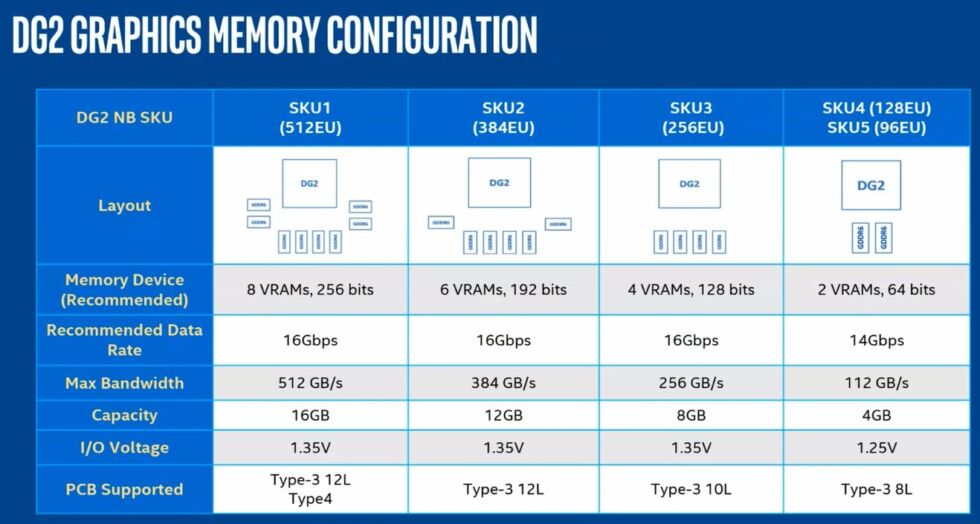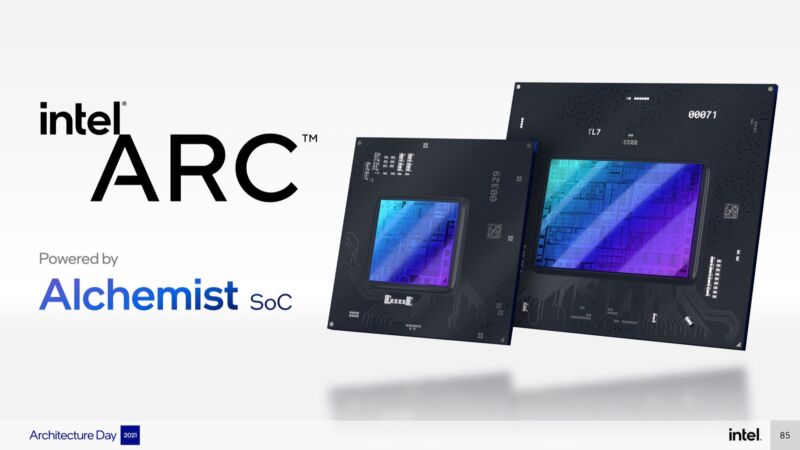Intel hasn’t said much about its upcoming Arc dedicated GPUs since announcing their branding and a handful of architectural details a few months ago, but recent leaks have given us some indications of what we can expect when it comes to performance and to the GPUs that Intel is planning for laptops later this year.
Of the leaks, the one about the laptop Arc models is more concrete. A slide originally leaked on Twitter outlines a total of five different GPU models for laptops, ranging from a couple of slow-but-better-than-integrated options at the bottom all the way to a potential high-end GeForce or Radeon competitor

The best of the GPUs includes 512 of Intel’s GPU execution units (EUs) attached to 16 GB of 16 Gbps video memory using a 256-bit interface; that wide a memory interface and that much memory suggests a high-end GPU that’s trying to compete with GeForce 3070- and 3080-series and Radeon 6800- and 6900-series products. The middle two GPU options—one 384 EU model with 12 GB of RAM connected to a 192-bit interface and one 256 EU model with 8 GB of RAM and a 128-bit interface—are reminiscent of the specs for Nvidia's mainstream RTX 3060 and 3050 laptop GPUs. The two low-end models, which connect to 4 GB of RAM with a 64-bit memory interface, seem poised to compete with GPUs like Nvidia's GeForce MX series or the beefed-up RDNA2 integrated GPUs in AMD's upcoming Ryzen 6000 laptop processors.
The slides’ use of “recommended” implies that laptop makers will have some room to tweak these options, most likely by using more or less (or faster or slower) RAM. This would be par for the course for the sometimes-confusing mobile GPU market, where the “same” model GPU can perform differently in different laptops depending on the specific hardware configurations, cooling systems, and power consumption settings that laptop makers choose. It's also difficult to draw conclusions on these GPUs' performance using just these on-paper numbers.
That leads us to the other recent Arc story: some SiSoftware benchmarks purporting to show an Arc desktop GPU's performance surfaced last week, pointing to a 512 EU model that was roughly competitive with an Nvidia RTX 3070 Ti (albeit with more impressive-looking numbers for GPU computing tasks than for gaming). Assuming Intel gets close to RTX 3070-tier performance with that desktop part, it's not unreasonable to assume 3060-ish and 3050-ish performance targets for the more modest 384 and 256 EU products. That said, these numbers are (at best) an unverified performance preview using non-final hardware and drivers in a single benchmark, so we shouldn't draw too many conclusions from those numbers in isolation.
Intel's Arc GPUs were originally supposed to begin appearing in the first quarter of 2022, though references to "Q1" have since been removed from Intel's website. Some laptop announcements from CES earlier in January mentioned Arc GPUs, but with no specs or performance numbers included, and Intel hasn't been forthcoming with specifics. The GPU shortage is still bad enough that even decidedly mediocre products are being bought as fast as the GPU companies can make them, so chances are that Intel's GPUs will sell well even if they're objectively not all that impressive. They just have to be released first.



3175x175(CURRENT).thumb.jpg.b05acc060982b36f5891ba728e6d953c.jpg)


Recommended Comments
Join the conversation
You can post now and register later. If you have an account, sign in now to post with your account.
Note: Your post will require moderator approval before it will be visible.